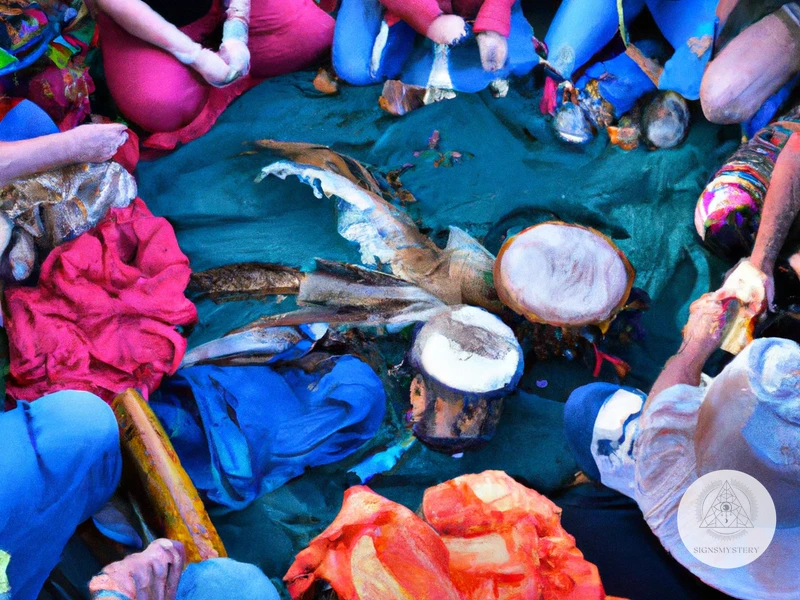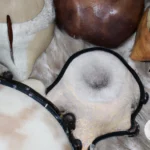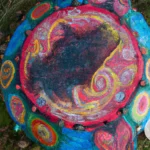The practice of shamanism has been around for centuries and is still relevant today. One of the key tools used in shamanic practices is the drum. The drum has been utilized in shamanic circles to connect with the spiritual world, facilitate healing, and induce trance states. There are various drums used in shamanic practices, each with their unique qualities and characteristics. In this article, we’ll explore the different types of drums used in shamanic drum circles, their respective qualities and characteristics, and how to choose the right drum for you. Join us on this journey of discovery as we delve into the power of the drum in shamanic practices.
The Power of the Drum in Shamanic Practices
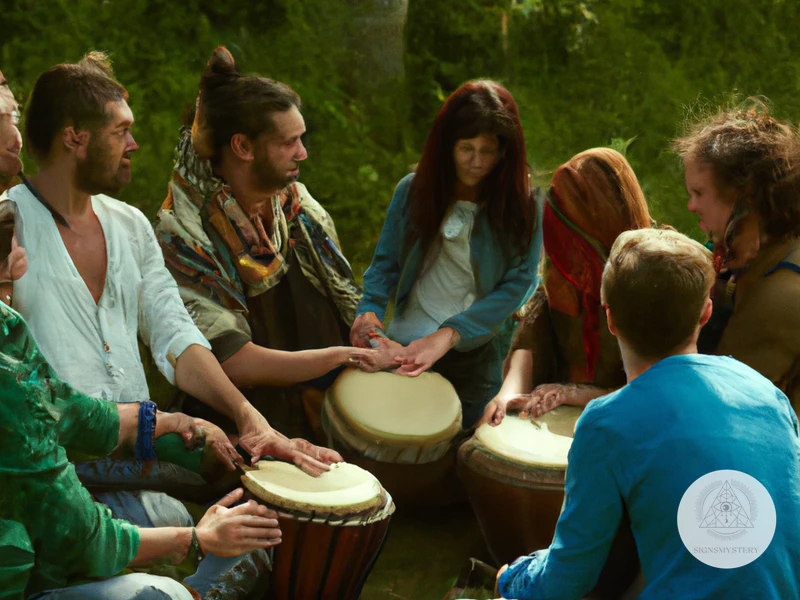
In shamanic practices worldwide, the drum is an essential tool for spiritual healing and connection. The rhythmic beat of the drum provides a steady anchor for shamanic journeying, meditation, and deep states of consciousness. The sound of the drum can help to alter brain waves, inducing a state of relaxation and facilitating access to inner wisdom and intuition. Through drumming, shamanic practitioners can move energy, connect with spirit guides, and release emotions. The drum is a powerful symbol in shamanism, representing the heartbeat of the earth and the universe. Its sound embodies the cyclical and repetitive nature of life and the journey of the soul. To learn more about the significance of drumming in shamanic traditions, check out our article on shamanic drumming rhythms and tempo.
Why Use a Drum in Shamanic Practices
The power of the drum in Shamanic practices has been recognized by indigenous cultures for thousands of years. The reason for using a drum in shamanic practices is to help the shaman or practitioner shift their consciousness into a trance-like state. This altered state of consciousness allows them to connect with the spiritual realm and receive guidance and wisdom. The sound and vibration produced by the drum can also serve to clear negative energy and strengthen the energy field of the individual and the group participating in the practice.
The drum has the ability to create a bridge between the conscious mind and the subconscious mind. In shamanic practices, the sound of the drum can facilitate shamanic journeying, which involves using the sound of the drum to enter into a trance-like state and explore different realms for spiritual guidance. The beat of the drum can also be used for entrainment, a process in which the body and mind synchronize with the rhythm of the drumbeat, promoting relaxation and a sense of interconnectedness.
Using a drum in shamanic practices can also have a powerful symbolic significance. The drum represents the heartbeat of both the individual and the collective community, connecting all beings and living things. The drum circle experience promotes a sense of community and unity, creating a space where individuals can feel safe and supported.
Using a drum in shamanic practices is an important aspect of connecting with the spiritual realm, clearing negative energy, and promoting relaxation. The symbolic significance of the drum also helps to create a sense of community and interconnectedness. If you want to learn more about shamanic drumming and how to start your own drum circle community, check out our guide on how to start a drum circle community or the benefits of therapy drum circles.
How the Drum is Used in Shamanic Practices
The drum is the primary tool used in shamanic practices, specifically in shamanic drumming, a technique used to enter altered states of consciousness. The rhythmic beat of the drum allows the shaman to achieve a trance-like state, which enables them to access the spirit realm and communicate with spirits and other entities.
During a shamanic practice or ceremony, the drummer often plays a repetitive beat that maintains a steady rhythm. This is done to allow the shaman to focus their intention and allow their mind to enter a state of tranquillity. The drumbeat is also used to set the pace for other practitioners involved in the ceremony, encouraging them to synchronize their movements and intentions.
In shamanic journeying, the shaman may use the drum to signal the beginning and end of the journey. This allows the practitioner to enter and leave the spirit realm safely and makes the journey more structured and intentional. The drumbeat may also be used to guide the shaman through the journey and help them remain focused along the way.
The drum is sometimes used to cleanse negative energy before shamanic practice. By playing the drum and focusing intention, the shaman can create a space that is safe and free from negativity, enabling them to connect more powerfully with the spirit realm.
The drum is a vital tool in shamanic practices and is used in a multitude of ways, from journeying to cleansing to entering altered states of consciousness. The practice of shamanic drumming has played an essential role in many cultures and continues to do so today.
If you’re interested in learning more about drum circles in shamanism, check out Drum Circle Shamanism.
Types of Drums Commonly Used in Shamanic Practices
Shamanic drum circles are a significant part of shamanic practices. The use of different types of drums helps create a unique rhythm, sound, and vibration, which can influence the journey experience. Bodhrán, a traditional Irish drum, is commonly used in shamanic practices for its deep and rich sound. Djembe, a rope-tuned skin-covered goblet drum, is versatile and produces a range of sounds. Ashiko, a tapered cylinder-shaped drum, is known for its resonant bass tones. Frame drum, also known as a Shamanic drum, is used for its simplicity and its ability to produce rhythmic patterns. Talking drum is a West African drum that produces a talking or singing-like sound. Lastly, the Buffalo drum is a Native American drum that is large and produces a deep and resonant sound. Each of these drums has a unique sound and is used in shamanic practices for different reasons.
Bodhrán
The is a type of drum that originated in Ireland and is commonly used in Shamanic practices. It is a shallow, circular drum that is played with a double-ended stick called a tipper. The Bodhrán is often used in conjunction with the Shamanic journeying practice, as the steady rhythm it produces can help to transport the participant into a trance-like state.
The Bodhrán is often made from goat skin and has a distinctive sound that is both deep and resonant. It is typically played with the tipper in one hand, while the other hand is used to change the pitch of the drum by applying pressure to the skin. This produces a range of tones that can be used to create complex rhythms.
One of the advantages of the Bodhrán is its simplicity. It is a relatively easy drum to learn to play, making it accessible to beginners. However, it also has a dynamic range that makes it suitable for more advanced players. Its versatile nature means that it can be used in a wide range of Shamanic practices, and it is often a favorite instrument for those who prefer a more gentle, meditative type of drumming.
Additionally, the Bodhrán has a rich history and tradition, which can add an element of depth and meaning to Shamanic practices. For those who are interested in learning more about this instrument and its role in Shamanic practices, there are many resources available that offer guidance on how to play the Bodhrán and incorporate it into Shamanic rituals.
The Bodhrán is a popular choice for Shamanic practitioners who are looking for a versatile and accessible drum that can be used in a variety of contexts. Whether you are a beginner or an advanced player, the Bodhrán can be an excellent instrument to explore as part of your Shamanic practice.
Djembe
is one of the most popular types of drums used in shamanic drum circles. Originating from West Africa, Djembe is a goblet-shaped drum made from a single piece of hardwood with a goat or cowhide drumhead stretched over the top. This type of drum produces a wide range of tones, allowing players to create complex rhythms and sounds.
In traditional West African culture, Djembe was used in various ceremonial and social events, including weddings, funerals, and initiations. It was believed that the drum had spiritual qualities that could communicate with the spirits and ancestors. Today, it is commonly used in shamanic practices to induce trance states and facilitate healing.
Djembe is known for its powerful and energetic sound, which can evoke strong emotions and feelings. Its unique tones and rhythms can transport listeners to different realms and connect them to their inner selves. When played in a group setting, Djembe can enhance the collective energy and create a sense of unity and harmony.
To play Djembe, one needs to strike the drumhead with bare hands or a percussion instrument, such as a stick or mallet. Each part of the drumhead produces a different tone, allowing players to create a variety of rhythms and melodies. Djembe players often use specific techniques, such as slaps, tones, and bass hits, to produce different sounds and effects.
When choosing a Djembe for shamanic practices, it’s important to consider the size, weight, and quality of the drum. A well-made Djembe should have a resonant sound, a tight drumhead, and a sturdy frame. It should also be comfortable to play and easy to carry around.
Djembe is a versatile and powerful drum that can enhance shamanic practices and create transformative experiences. Its unique tones, rhythms, and spiritual qualities make it a popular choice among shamanic practitioners and drum circle enthusiasts. If you’re interested in learning more about Djembe and shamanic drumming, check out our article on drums for shamanic practice.
Ashiko
The Ashiko is a goblet-shaped drum that originates from West Africa and is used widely in shamanic practices. It is carved from a single log and covered with animal skin. One of the unique features of the Ashiko is that its head is typically thinner and more elastic compared to other drums, which produces a higher pitch and sharper notes when played. This factor makes the Ashiko a treasured drum in shamanic drumming because the sound it produces can penetrate through deep meditations and inner travels.
The Ashiko drum has a powerful energy that is known to have the ability to connect the player and listener with the Earth’s core. When played during Shamanic journeys, it serves as a transformational tool to bring people to heightened states of consciousness, where they can communicate with spirits, ancestors, and the divine.
The Ashiko drum is known to have a strong masculine energy given its association with the warrior and hunter traditions of West Africa. It is a symbol of courage, strength, and resilience. As such, when played, the Ashiko drum evokes a sense of bravery, creating a space where participants can connect with their inner power and resolve inner conflicts.
One of the unique benefits of the Ashiko drum is its versatility: it can be played quietly or loudly, depending on the intention of the player or the energy of the circle. If a person is joining a shamanic drum circle for the first time, the Ashiko may be a great option as it has the power to ease participants into a shamanic journey and open them up to the transformative effects of the experience.
To experience the transformative effects of the Ashiko and other types of shamanic drums, preparation and a proper understanding of the drum circle symbolism are critical. Knowing how to set intentions, hold space, and manage the group’s energy are crucial elements to consider for a successful shamanic drum circle experience. For more in-depth information on this topic, check out /Drum Shamanic Journeying/, /Successful Drum Circle Tips/, /Shamanic Drum Circle Symbolism/, and /Intention Setting in Shamanic Drumming/.
Frame Drum
The is a versatile and ancient instrument commonly used in shamanic practices. It is a circular drum with a simple design, usually made from wood with a natural skin drumhead. The frame drum is played by holding it in one hand and striking it with the other.
One of the most significant characteristics of the frame drum is its rich history. This drum has been found in many cultures and civilizations, including ancient Egypt, Greece, and Rome. It has been used for centuries in religious and spiritual ceremonies, creating a deep connection between the drum and the human spirit.
Frame drums come in various sizes, ranging from small to large, and can vary in depth and diameter. A smaller frame drum produces a higher pitch, while a larger frame drum produces a deeper, more resonant sound.
The frame drum can produce a range of tones, from soft and subtle to loud and emphatic. It is often played in shamanic practices as a way to communicate with spirits, bring focus to meditation and induce trance-like states.
Choosing a frame drum that resonates with you is essential. When choosing a frame drum, it is important to try out a few different ones to see which feels most comfortable and produces the sound you desire. Some things to consider include the weight of the drum, the material it is made from, and the quality of the skin drumhead.
The frame drum is a significant instrument in shamanic practices which has stood the test of time. Its ancient history and unique sound make it an excellent choice for those seeking to deepen their spiritual journey with percussion.
Talking Drum
The is a unique type of drum widely used in West Africa, especially in Nigerian and Ghanaian cultures. This drum is carved from a single piece of wood and it is decorated with intricate carvings on its body. What makes the Talking Drum unique is that it is an hourglass-shaped drum that can be squeezed under the arm to change its pitch, creating a “talking” rhythm.
Traditionally, the Talking Drum was used as a means of communication over long distances, as its pitch could mimic tonal languages. By squeezing the drum while playing, skilled drummers could communicate complex messages to other drummers and communities. In the context of shamanic practices, the Talking Drum can be used to communicate with spirits or as a form of meditation.
The Talking Drum is usually played with a curved stick or hand, and it has a high-pitched sound that can cut through the din of other instruments. It is often played as a lead instrument in drum circles, and its distinctive style and tonal range make it an effective tool for creating a trance-like atmosphere.
When choosing a Talking Drum, it is important to consider its sound quality, which can vary depending on the size, shape, and type of wood used to make the drum. Some Talking Drums are made with synthetic materials, making them more durable and affordable, while others are still handmade with natural materials. It is also important to choose a drum that feels comfortable to play and resonates with your personal energy.
Buffalo Drum
The Buffalo Drum is a powerful and deep-sounding drum that is popularly used in shamanic practices. As its name suggests, it is made from buffalo hide, which is known for its sturdy and durable characteristics. The drum is usually large and has a wide and round frame, giving it a deep and booming sound that resonates through the body.
Qualities and Characteristics of the Buffalo Drum
Here are some characteristics of the Buffalo Drum that make it a unique and special instrument:
- Size: Buffalo drums typically range from 14 to 36 inches in diameter, making them one of the largest drums used in shamanic practices.
- Materials: The drumhead is made from buffalo hide, while the frame is usually made from thick wood or sturdy synthetic material.
- Sound: The Buffalo Drum is known for its deep and resonant sound, which can be felt throughout the body. The low frequency of the sound can help induce a trance-like state and facilitate deep healing.
- Symbolism: The buffalo is a sacred animal in many indigenous cultures, symbolizing strength, abundance, and groundedness. The use of a buffalo drum can help connect the player to the energy and spirit of the animal.
- Cultural Significance: The Buffalo Drum has long been used in indigenous cultures for spiritual purposes, including healing, communication, and ceremonial practices. By playing a buffalo drum, one can feel a deep sense of connection to these cultural traditions and ancestral wisdom.
Playing the Buffalo Drum
Playing the Buffalo Drum requires a certain level of skill and technique, as well as respect for the drum and its cultural significance. Here are some tips on how to play a buffalo drum effectively:
- Hold the Drum Properly: The drum should be held vertically so that the player can easily strike the center of the drumhead with their beater.
- Find a Steady Rhythm: The Buffalo Drum is best played with a steady and consistent beat, which can help induce a meditative state and aid in healing.
- Use Different Techniques: Players can experiment with different playing techniques, such as varying the strength and speed of the strikes or using different parts of the hand and fingers.
- Connect with the Energy of the Drum: To fully connect with the energy and spirit of the Buffalo Drum, players can take a moment to set an intention or prayer before beginning to play.
The Buffalo Drum is a powerful and significant instrument that has been used for spiritual purposes for centuries. Its deep and resonant sound, cultural significance, and grounding qualities make it an ideal choice for shamanic practices and other spiritual pursuits.
Qualities and Characteristics of Different Types of Drums
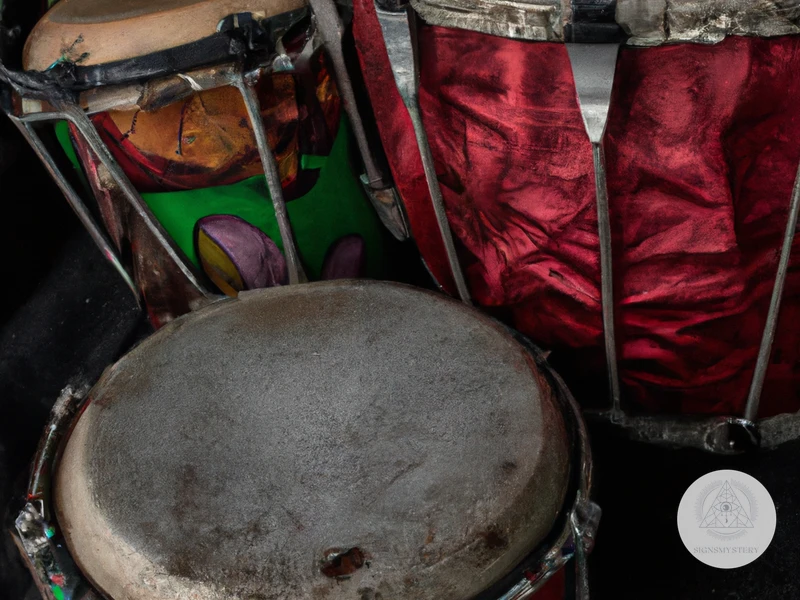
Each type of drum commonly used in shamanic practices has unique qualities and characteristics. The Bodhrán, an Irish drum, is known for its deep and resonant sound. The Djembe, originating from West Africa, is a versatile drum that can produce a wide range of tones and can be played for extended periods without causing fatigue. The Ashiko, also from West Africa, is a cylindrical drum with a narrow base and produces a deep and booming sound. The Frame Drum, found in several cultures worldwide, has a simple design and produces a warm and mellow sound. The Talking Drum, also from West Africa, is a drum with a unique twist; it can be squeezed to create different tones, mimicking human speech. Lastly, the Buffalo Drum, originating from Native American traditions, is a large and sturdy drum with a deep and resonant sound. Each drum brings its unique qualities, making them valuable assets in shamanic practices.
Bodhrán
The is a traditional Irish drum that is commonly used in Shamanic drum circles. It is a handheld drum made with a wooden frame and a stretched animal skin head, often goat skin. The drum is played with a double-ended stick, known as a tipper or beater, which is held in one hand while the other hand strikes the drumhead.
The Bodhrán is an incredibly versatile instrument that can produce a diverse range of tones and pitches based on where and how it is struck. It has a unique ability to mimic the sound of hoofbeats, which can be a powerful tool in Shamanic practices.
Traditionally, the Bodhrán was used as a percussive accompaniment to Irish music, but it has also been adapted to work in Shamanic practices. Its simple design and ease of use make it an accessible option for beginners, while its range and versatility make it a favorite among experienced drummers.
In Shamanic practices, the Bodhrán is often used to provide a steady beat to help guide participants into a meditative state. It can also be used for journeying, where the drummer uses the rhythms of the drum to guide themselves deeper into a trance state.
The Bodhrán is a powerful and versatile instrument that can be a valuable addition to any Shamanic drum circle. Its unique ability to mimic the sound of hoofbeats and its versatility make it a great choice for any drummer, and its accessibility makes it a great starting point for those new to Shamanic practices.
Djembe
The Djembe is a type of West African drum that has gained worldwide popularity due to its unique sound and versatility. Its popularity has made it a common instrument in Shamanic drum circles.
Qualities and Characteristics of the Djembe
| Size: | The Djembe typically ranges from 11 to 15 inches in diameter and is about 24 inches in height. |
| Materials: |
|
| Sound: | The Djembe has a deep, resonant bass tone and a sharp, crisp slap, allowing forSubscribe to Our NewsletterSign up to receive the latest news and updates. |
| Playing Technique: |
|
| Cultural Significance: |
|
If you are looking for a drum that can produce a diverse range of sounds and rhythms, the Djembe is an excellent choice. Its unique sound and cultural significance make it a popular instrument in Shamanic drum circles, as well as in other types of music and spiritual practices.
Ashiko
The Ashiko is a type of drum that comes from West Africa. It is also sometimes referred to as a “djembe bass” because of its similar shape and size to the Djembe drum. However, the Ashiko has a wider base and a narrower top compared to the Djembe.
Qualities/Characteristics:
- The Ashiko is typically made from a single piece of hollowed out wood, usually from a tree like the iroko or the mahogany.
- It has a long and cylindrical shape, with a rounded bottom and a narrow top.
- The head of the drum is typically made from animal hide, usually goat or cow.
- Traditionally, the hide is stretched over the top of the drum and secured with rope or twine.
- The Ashiko is played with bare hands, with the player positioned in a way that allows them to use their whole hand to strike the drumhead.
- It is known for its deep, resonant bass tones and its ability to produce a wide range of sounds, including slaps and high-pitched tones.
The Ashiko is a versatile drum that is often used in shamanic practices because of its ability to produce a wide range of sounds and its deep, resonant tones. Its unique shape and construction make it a visually striking instrument as well. If you are looking for a drum that can produce a variety of tones and has a rich cultural history, the Ashiko may be the perfect choice for you.
Frame Drum
The is a type of drum that has been used by shamans for centuries due to its powerful sound and versatility. It is perhaps the simplest design among the drums commonly used in shamanic practices, yet is still capable of producing an array of tones and rhythms.
One of the unique characteristics of the frame drum is its construction. It consists of a flat and circular frame made of wood, with a stretched animal skin or synthetic drumhead on one or both sides. The drumhead is usually played with the hands, although some practitioners also use drumsticks.
The frame drum has a distinctive sound that can be described as deep and resonant, with a slightly higher pitched tone than the Bodhrán or Buffalo Drum. It is often used to create a consistent and steady beat that can help to induce an altered state of consciousness during shamanic rituals.
Due to its simplicity, the frame drum is also highly versatile. It can be used to produce a variety of rhythms and sounds, from a slow and steady heartbeat-like rhythm to a fast and energetic beat. This versatility makes it a popular choice among shamanic practitioners.
The frame drum is a powerful and versatile tool that has been used in shamanic practices for centuries. Its unique construction and sound make it an essential component of any shamanic drum circle or ritual.
Talking Drum
The is a unique drum that has been used in Africa for centuries. It gets its name from the fact that it can mimic the tonal and rhythmic patterns of human speech. The drum is hourglass-shaped, with two heads that are connected by ropes or cords.
The player holds the drum under one arm and uses their other hand and a curved stick to strike the drumhead. By adjusting the tension of the cords, the pitch of the drum can be changed to produce different tones. The drummer also uses their arm to press against the drum’s body, causing the pitch to bend.
One of the most fascinating things about the Talking Drum is its ability to convey messages. Skilled players are able to imitate the tonal patterns and intonations of spoken language, which allows them to “speak” through the drum. The drummer can transmit messages, convey warnings, or communicate emotions through the rhythms they play.
The Talking Drum has always been an important part of African culture and is still used today in many different settings. It is commonly used during ceremonies, celebrations, and festivals. The drum has even been incorporated into modern music genres like jazz, reggae, and hip-hop.
As with all drums used in shamanic practices, the Talking Drum has its own unique qualities and characteristics. It is believed to have a strong connection to the spirit world and can be used to call upon ancestral spirits and deities. The drum has a powerful, rhythmic energy that can be felt by those who hear it, making it a valuable tool for inducing trance states and altered states of consciousness.
When choosing a drum for shamanic practices, it’s important to consider personal preference and connection. The Talking Drum may be the perfect choice for those who feel drawn to its unique sound and cultural significance. With its ability to “speak” and convey messages, this drum can be a valuable tool for anyone looking to explore the spiritual realm through sound and rhythm.
Buffalo Drum
The Buffalo Drum is a popular choice for shamanic drumming circles and is often used for healing purposes. The drum is made from a solid wooden frame and covered with buffalo hide or other natural materials. It produces a deep, resonant sound that is said to help ground the participant and connect them with the spirit world.
Qualities and Characteristics
The following table outlines some of the key qualities and characteristics of the Buffalo Drum:
| Qualities | Characteristics |
|---|---|
| Size | The Buffalo Drum typically ranges in size from 12-24 inches in diameter. |
| Material | The frame is made from a solid wooden frame and covered with buffalo hide or other natural materials. This ensures that the drum is of high quality and will produce a sound that is both rich and powerful. |
| Sound | The sound produced by the Buffalo Drum is deep and resonant, making it the perfect choice for grounding and connecting with the spirit world. It is said that the sound can help to cleanse negative energy and promote healing. |
| Symbolism | The Buffalo is a powerful symbol of strength, abundance, and spirituality in many Native American cultures. The use of the Buffalo Drum is seen as a way of harnessing this power and connecting with the spirit of the animal. |
Playing the Buffalo Drum
To play the Buffalo Drum, the participant typically sits with the drum on their lap or on the ground in front of them. They then use a soft mallet or their hand to strike the drum and produce a deep, resonant sound. The sound can be repeated in a slow, steady rhythm or varied to produce different tones and rhythms.
Choosing a Buffalo Drum
When choosing a Buffalo Drum, it’s important to consider factors such as size, material, and sound quality. It’s also important to choose a drum that resonates with your personal beliefs and intentions for shamanic drumming. Some people prefer to create their own drum using materials that hold personal significance, while others may purchase a pre-made drum.
The Buffalo Drum is a powerful and popular choice for shamanic drumming circles. Its deep, resonant sound and connection to Native American symbolism make it a valuable tool for promoting healing and spiritual growth. When choosing a Buffalo Drum, it’s important to select one that resonates with your personal beliefs and intentions for shamanic practices.
Choosing the Right Drum for You
When it comes to choosing the right drum for your shamanic drum circle, there are a few factors to keep in mind. First, consider the type of music and rhythm you want to create. Each type of drum has its own unique sound and tone, so it’s important to choose one that aligns with your personal preference and the style of shamanic practice you will be engaging in. Another factor to keep in mind is the size and weight of the drum. Some drums, like the djembe, can be quite heavy and difficult to transport, while others, like the bodhrán, are more compact and lightweight. Additionally, consider the materials used to make the drum. Natural materials like hide or wood may have a more authentic sound, while synthetic materials may be more durable and weather-resistant. Ultimately, the right drum for you is the one that you feel a personal connection with and that helps you feel grounded and connected to the rhythm of the circle.
Factors to Consider When Choosing a Drum
When choosing a drum to use in shamanic practices, there are several important factors to consider. One of the most important considerations is the size of the drum. Drums come in a variety of sizes, from small handheld drums that are easy to carry around to larger drums that are meant to be played on the ground. The size of the drum will determine both the sound it makes and how it feels to play.
Another important consideration is the material from which the drum is made. Traditional shamanic drums are typically made from natural materials such as animal skin and wood. However, modern drums can be made out of synthetic materials as well. The material from which the drum is made will affect its sound and durability.
The design of the drum is another important factor to consider. Drums can be painted or decorated in various ways, and some drums feature intricate designs that are unique to the culture in which they were created. Consider what type of design speaks to you and feels meaningful.
Lastly, you should consider your budget. Drums can vary in price from a few dollars to well over a thousand dollars. It’s important to find a drum that fits your budget while also meeting your needs and preferences.
Ultimately, the choice of a drum is a personal one that will depend on your individual needs and preferences. When choosing a drum, take the time to evaluate each of these factors and weigh them against your own personal preferences and connection to the drum. This will help you find a drum that feels both powerful and meaningful.
Personal Preference and Connection
When it comes to choosing the right drum for you, personal preference and connection is definitely a key factor to consider. Each type of drum has its own unique sound and energy, and it’s important to choose a drum that speaks to you on a personal level.
One aspect to consider is the material the drum is made from. For example, a bodhrán made from goatskin may feel more connected to nature for some individuals, while a buffalo drum made from cowhide may feel more powerful and grounding. Additionally, the artwork or design on the drum can also play a role in personal connection. Some may resonate more with a drum that has a specific symbol or image, while others may prefer a simpler, more traditional design.
Another important factor is the size and shape of the drum. Smaller drums may be more portable and easier to carry around, while larger drums may have a deeper, more resonant sound. Some individuals may also find that a particular shape or style of drum feels more comfortable or natural for them to play.
The most important thing is to choose a drum that resonates with you on a deep level and feels like a true extension of yourself and your energy. As with any spiritual tool, the connection between the individual and the instrument is key to unlocking its full potential and power.
| Factors to Consider When Choosing a Drum: |
|---|
| Material: Consider the type of material the drum is made from and how it resonates with you. |
| Artwork/Design: Look for a drum that has a design or symbol that speaks to you personally. |
| Size/Shape: Choose a drum that feels comfortable to play and creates the sound you desire. |
| Personal Connection: Go with your intuition and choose a drum that resonates with you on a deep level. |
Conclusion
In conclusion, exploring the different types of drums used in shamanic drum circles can be an enriching experience for anyone interested in this ancient and powerful practice. From the Bodhrán with its deep and rich sound to the Djembe with its versatility and range, each drum has its unique qualities and characteristics that make it suited for specific purposes. A drum that resonates with you on a personal level can facilitate a deeper connection with the shamanic practice and the spiritual realm.
When choosing a drum, it is important to consider factors such as size, materials, and sound quality, but ultimately, personal preference and connection should guide the decision-making process. Whether you are a beginner or an experienced practitioner, the right drum can enhance your journey and enrich your experience in shamanic drum circles.
Remember that the power of the drum in shamanic practices goes beyond mere sound vibrations. It carries the energy of the collective consciousness of the group and connects everyone in the circle to the heartbeat of the earth. Each beat, each rhythm, and each sound creates a sacred space where healing and transformation can occur.
So, whether you prefer the traditional Irish Bodhrán or the West African Djembe, embrace the magic of the drum and allow it to guide you on your shamanic journey. With an open mind and heart, you can tap into your own inner wisdom and connect with the spirit world in a profound and transformative way.
Frequently Asked Questions
1. Can anyone participate in a shamanic drum circle?
Yes, anyone can participate regardless of their age or musical ability. The focus is on the intention and energy of the group rather than individual performance.
2. Do I need to bring my own drum to a shamanic drum circle?
It depends on the group. Some groups may have extra drums to loan out, while others may require each participant to bring their own drum or percussion instrument.
3. What should I wear to a shamanic drum circle?
Wear comfortable and loose-fitting clothing that allows for movement and ease of playing your drum. Natural fibers like cotton or linen are recommended.
4. How long does a typical shamanic drum circle last?
The length of a shamanic drum circle can vary depending on the group, but typically lasts anywhere from one to three hours.
5. Can I bring other instruments to a shamanic drum circle?
Yes, other instruments such as rattles, bells, or singing bowls can be used in addition to drums to enhance the overall sound and energy of the circle.
6. Is there a specific way to play a drum in a shamanic drum circle?
While there are no set rules, it is recommended to play with intention and to listen to the other drummers in the group to create a unified and harmonious sound.
7. Can shamanic drumming be done alone?
Yes, solo shamanic drumming can be a powerful practice for connecting with one’s inner self and the spiritual realm.
8. Are there any health benefits to shamanic drumming?
Studies have shown that shamanic drumming can reduce stress, lower blood pressure, and enhance overall well-being.
9. Can shamanic drumming help with meditation?
Yes, the repetitive and hypnotic beat of shamanic drumming can help to induce a meditative state and enhance focus and concentration.
10. Is there a spiritual significance to the different types of drums used in shamanic practices?
Yes, each type of drum has its own unique character and cultural significance, and can be used to connect with specific spiritual energies and traditions.

